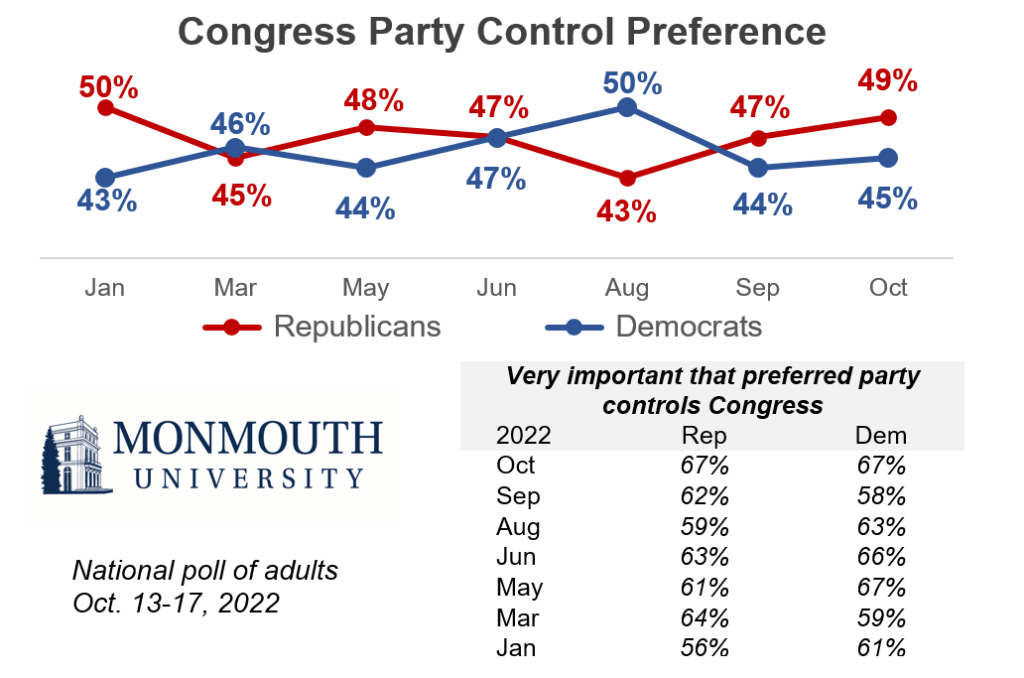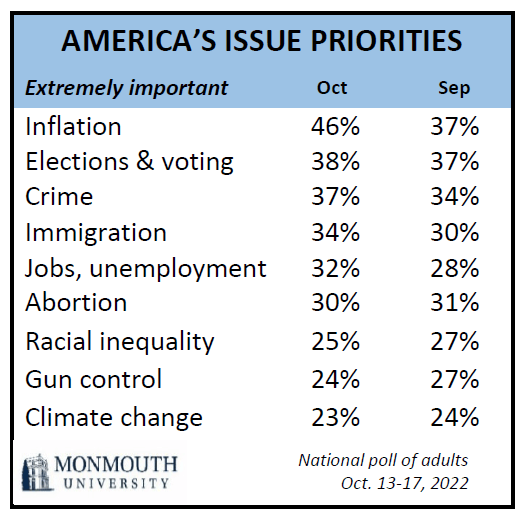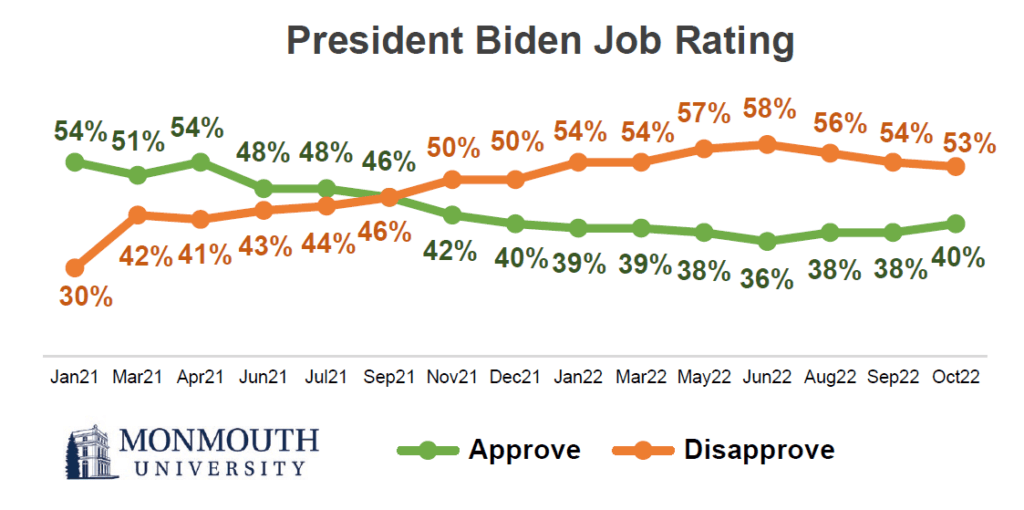West Long Branch, NJ – More Americans are struggling economically than felt that way at the prior midterm elections four years ago. Most say President Joe Biden has not been paying attention to their most important concerns as inflation continues to be the top issue in this cycle, according to the latest national Monmouth (“Mon-muth”) University Poll. Republicans continue to hold a slight edge in preference for congressional control.
Republicans maintain a slight edge in preference for party control of Congress. Currently, 40% of Americans say they want the GOP in charge and another 9% have no initial preference but lean toward Republican control. Democratic control is preferred by 35% with another 10% leaning toward the Democrats. Last month, 47% preferred or leaned toward the GOP and 44% favored the Democrats.

The number of Americans who say it is very important to have their preferred party in control of Congress has ticked up since last month, although there is no difference between those who want Republicans (67%) or Democrats (67%) in charge. On the question of enthusiasm, though, Americans who want a GOP-led Congress (64% extremely motivated) continue to be more motivated than those who want to keep Democrats in charge (59%).
“Simply put, America remains divided, but the fundamentals and issue environment gives a small but consequential edge to Republicans,” said Patrick Murray, director of the independent Monmouth University Polling Institute.
Monmouth asked about the importance of nine issue areas for the federal government to address in each of its last two polls. There has been little overall change in the priority attached to these issues, except that the number of people who rate inflation as extremely important has increased from 37% in September to 46% in the current poll. This is due mainly to large jumps among Republicans (from 46% to 65%) and Democrats (from 23% to 36%), while independents’ opinion on this priority has remained stable (from 41% to 42%). Republicans’ concerns about immigration (from 46% to 58%) along with elections and voting issues (from 37% to 49%) have also increased from last month.

“Inflation has become even more front and center than it already was. On one hand, the partisan shift on this issue could result in more enthusiastic Republicans and less motivated Democrats. On the other hand, the effect of this issue may be capped among more persuadable voters,” said Murray. He added, “Inflation, immigration, and crime continue to spur GOP voters, along with an increased concern about elections and voting. The House committee calling the former president to testify about the U.S. Capitol attack may have helped raise the salience of this issue among voters who continue to falsely believe the 2020 election was stolen.”
Perception of President Biden’s performance on bread-and-butter concerns is not helping the Democratic cause. Just 31% say he has been giving enough attention to issues that are most important to American families. The majority (63%) wish he would give these issues more attention. By comparison, a poll taken just after the 2018 midterm elections found that 38% believed then-President Donald Trump was giving these issues enough attention and 56% said he was not. Fewer independents feel Biden is paying attention to their top issues (26%) than said the same about Trump four years ago (37%). Perhaps even more telling, while 72% of Republicans felt Trump was paying attention to their most important issues in 2018, fewer Democrats (58%) say the same about Biden today.
“Democrats took the House four years ago largely on the back of anti-Trump sentiment. While many aspects of these two elections are different, some of the performance metrics that were a drag on Trump look even worse for Biden,” said Murray.
Currently, 40% approve of the overall job Biden is doing as president while 53% disapprove. This is a slight improvement from where he stood in June (36% approve and 58% disapprove), but is statistically similar to his job rating last month (38% approve and 54% disapprove). In November 2018, Trump held a 43% approve and 49% disapprove job rating.

Nearly 4 in 10 Americans (37%) say they are struggling to remain where they are financially. This is down slightly from 42% who said the same in June, but still higher than the range of 20% to 29% in Monmouth polls taken between 2017 and 2021 (* see note). In the current poll, half (51%) say their current financial situation is basically stable and only 11% say it is improving. Reports of struggling financially come from 50% of those earning under $50,000 (up 10 points from June 2021), 34% of those earning $50,000-$100,000 (up 14 points), and 24% of those earning over $100,000 (up 14 points).
One-third of the public (34%) says increases in gas prices have caused them a great deal of financial hardship, which is similar to poll results from March (38%). Still, most Americans say they are optimistic (59%) about what their family’s financial situation will be 12 months from now, while 37% are pessimistic. There are no significant differences by income level in this outlook.
Examining these results by preference for control of Congress finds that those who back Republicans are more negative than Democratic supporters about their current and future finances. Among those who have no clear party preference, 39% say they are struggling financially and 35% are pessimistic about their situation in the near future. This group also rates inflation (37% extremely important) higher than other concerns as an issue for the federal government to address.
“There is some uncertainty among voters who do not have a clear preference in the upcoming midterms. They are concerned about rising prices, but they are not overly pessimistic. It’s not clear whether one party or the other can draw their support, or whether their ambiguity means they opt out of the election entirely,” said Murray.
The Monmouth University Poll was conducted by telephone from October 13 to 17, 2022 with 808 adults in the United States. The question results in this release have a margin of error of +/- 5.2 percentage points for the full sample. The poll was conducted by the Monmouth University Polling Institute in West Long Branch, NJ.
* Note on partisan results for financial situation question:
Monmouth’s question asking respondents to assess their current financial situation seems straightforward, but like almost all aspects of public discourse today, is filtered through a partisan lens. Even though the overall results for this question remained relatively stable from 2017 through 2021, there were huge partisan shifts after the White House changed hands. Specifically, 24% of Americans said they were struggling financially in both 2018 and 2021. However, the number of Republicans who reported this situation jumped from 14% to 30% after the presidency changed from Trump to Biden, while the number of Democrats who said they were struggling dropped from 34% to 17%. The results for independents were relatively stable (23% in 2018 and 27% in 2021). Thus, the results of this question as a neutral snapshot of personal finances should be viewed with this caveat in mind. Reports of struggling financially have increased since last year among all partisan groups, but more so among Republicans (+18 points) and independents (+12) than among Democrats (+7).
QUESTIONS AND RESULTS
(* Some columns may not add to 100% due to rounding.)
1.Do you approve or disapprove of the job Joe Biden is doing as president?
| TREND: | Oct. 2022 | Sept. 2022 | Aug. 2022 | June 2022 | May 2022 | March 2022 | Jan. 2022 | Dec. 2021 | Nov. 2021 | Sept. 2021 | July 2021 | June 2021 | April 2021 | March 2021 | Jan. 2021 |
| Approve | 40% | 38% | 38% | 36% | 38% | 39% | 39% | 40% | 42% | 46% | 48% | 48% | 54% | 51% | 54% |
| Disapprove | 53% | 54% | 56% | 58% | 57% | 54% | 54% | 50% | 50% | 46% | 44% | 43% | 41% | 42% | 30% |
| (VOL) No opinion | 7% | 8% | 7% | 6% | 5% | 7% | 7% | 11% | 9% | 8% | 8% | 9% | 5% | 8% | 16% |
| (n) | (808) | (806) | (808) | (978) | (807) | (809) | (794) | (808) | (811) | (802) | (804) | (810) | (800) | (802) | (809) |
2.Do you approve or disapprove of the job the U.S. Congress is doing?
| TREND: | Oct. 2022 | Sept. 2022 | Aug. 2022 | June 2022 | May 2022 | March 2022 | Jan. 2022 | Dec. 2021 | Nov. 2021 | Sept. 2021 | July 2021 | June 2021 | April 2021 | March 2021 | Jan. 2021 |
| Approve | 23% | 23% | 17% | 15% | 15% | 21% | 19% | 23% | 18% | 22% | 23% | 21% | 35% | 30% | 35% |
| Disapprove | 69% | 66% | 74% | 78% | 77% | 71% | 74% | 66% | 70% | 65% | 62% | 65% | 56% | 59% | 51% |
| (VOL) No opinion | 8% | 11% | 9% | 7% | 8% | 8% | 6% | 11% | 12% | 13% | 15% | 15% | 9% | 11% | 14% |
| (n) | (808) | (806) | (808) | (978) | (807) | (809) | (794) | (808) | (811) | (802) | (804) | (810) | (800) | (802) | (809) |
| TREND: Continued | Nov. 2020 | Early June 2020 | May 2020 | April 2020 | Feb. 2020 | Jan. 2020 | Dec. 2019 | Nov. 2019 | Sept. 2019 | Aug. 2019 | June 2019 | May 2019 | April 2019 | March 2019 | Jan. 2019 |
| Approve | 23% | 22% | 32% | 32% | 20% | 24% | 22% | 23% | 21% | 17% | 19% | 20% | 24% | 23% | 18% |
| Disapprove | 64% | 69% | 55% | 55% | 69% | 62% | 65% | 64% | 68% | 71% | 69% | 71% | 62% | 68% | 72% |
| (VOL) No opinion | 13% | 9% | 13% | 13% | 11% | 14% | 13% | 13% | 11% | 13% | 12% | 9% | 14% | 9% | 10% |
| (n) | (810) | (807) | (808) | (857) | (902) | (903) | (903) | (908) | (1,161) | (800) | (751) | (802) | (801) | (802) | (805) |
| TREND: Continued | Nov. 2018 | Aug. 2018 | June 2018 | April 2018 | March 2018 | Jan. 2018 | Dec. 2017 | Sept. 2017 | Aug. 2017 | July 2017 | May 2017 | March 2017 | Jan. 2017 |
| Approve | 23% | 17% | 19% | 17% | 18% | 21% | 16% | 17% | 18% | 19% | 19% | 25% | 23% |
| Disapprove | 63% | 69% | 67% | 71% | 72% | 68% | 65% | 69% | 69% | 70% | 68% | 59% | 66% |
| (VOL) No opinion | 14% | 14% | 14% | 12% | 11% | 11% | 19% | 15% | 13% | 11% | 13% | 16% | 11% |
| (n) | (802) | (805) | (806) | (803) | (803) | (806) | (806) | (1,009) | (805) | (800) | (1,002) | (801) | (801) |
| TREND: Continued | Sept. 2016* | Aug. 2016* | June 2016* | March 2016 | Jan. 2016 | Dec. 2015 | Oct. 2015 | Sept. 2015 | Aug. 2015 | July 2015 | June 2015 | April 2015 | Jan. 2015 | Dec. 2014 | July 2013 |
| Approve | 15% | 14% | 17% | 22% | 17% | 16% | 17% | 19% | 18% | 18% | 19% | 21% | 18% | 17% | 14% |
| Disapprove | 77% | 78% | 76% | 68% | 73% | 73% | 71% | 71% | 72% | 69% | 71% | 67% | 70% | 73% | 76% |
| (VOL) No opinion | 8% | 9% | 7% | 10% | 10% | 10% | 12% | 11% | 11% | 12% | 10% | 12% | 11% | 11% | 10% |
| (n) | (802) | (803) | (803) | (1,008) | (1,003) | (1,006) | (1,012) | (1,009) | (1,203) | (1,001) | (1,002) | (1,005) | (1,003) | (1,008) | (1,012) |
* Registered voters
3.Would you rather see the Republicans or the Democrats in control of Congress, or doesn’t this matter to you? [CHOICES WERE ROTATED] [If DOES NOT MATTER: If you had to lean one way or the other would you pick the Republicans or the Democrats?]
| TREND: | Oct. 2022 | Sept. 2022 | Aug. 2022 | June 2022 | May 2022 | March 2022 | Jan. 2022 |
| Republicans | 40% | 36% | 34% | 36% | 36% | 33% | 35% |
| Not matter, but lean Rep | 9% | 11% | 9% | 11% | 12% | 12% | 15% |
| Democrats | 35% | 34% | 38% | 38% | 34% | 33% | 33% |
| Not matter, but lean Dem | 10% | 10% | 12% | 9% | 10% | 13% | 10% |
| Does not matter, no lean | 5% | 8% | 5% | 6% | 7% | 9% | 7% |
| (VOL) Don’t know | 1% | 2% | 1% | 1% | 1% | 1% | 0% |
| (n) | (808) | (806) | (808) | (978) | (807) | (809) | (794) |
4.Is it very important, somewhat important, or only a little important to have [Republicans/Democrats] in control of Congress? [CHOICE READ FROM Q3]
| TREND: | Oct. 2022 | Sept. 2022 | Aug. 2022 | June 2022 | May 2022 | March 2022 | Jan. 2022 |
| Very important | 63% | 54% | 57% | 60% | 59% | 56% | 54% |
| Somewhat important | 18% | 22% | 24% | 20% | 20% | 21% | 23% |
| Only a little important | 12% | 11% | 11% | 11% | 12% | 12% | 15% |
| (VOL) Don’t know / Does not matter who controls Congress (from Q3) | 7% | 12% | 7% | 9% | 9% | 11% | 8% |
| (n) | (808) | (806) | (808) | (978) | (807) | (809) | (794) |
5.How motivated are you to vote in this year’s election – extremely motivated, very motivated, somewhat motivated, or not motivated?
| TREND: | Oct. 2022 | Sept. 2022 |
| Extremely motivated | 59% | 59% |
| Very motivated | 20% | 17% |
| Somewhat motivated | 10% | 13% |
| Not motivated | 9% | 10% |
| (VOL) Don’t know | 1% | 1% |
| (n) | (808) | (806) |
6.Regardless of whether you agree or disagree with President Biden, has he been giving enough attention to the issues that are most important to your family or do you wish he would give more attention to issues that are important to your family?
| COMPARISON: | BIDEN | TRUMP | ||||||||
| Oct. 2022 | March 2020 | June 2019 | Nov. 2018 | Sept. 2017 | Aug. 2017 | May 2017 | March 2017 | |||
| Giving enough attention | 31% | 45% | 41% | 38% | 37% | 40% | 34% | 36% | ||
| Wish he’d give more | 63% | 49% | 55% | 56% | 53% | 51% | 62% | 57% | ||
| (VOL) Don’t know | 6% | 6% | 4% | 6% | 10% | 9% | 5% | 7% | ||
| (n) | (808) | (851) | (751) | (802) | (1,009) | (805) | (1,002) | (801) |
7.I am going to read you a number of different issues and want you to tell me how important it is for the federal government to address these issues. For each one, please tell me if you feel it is extremely important, very important, just somewhat important, or not important? [ITEMS WERE ROTATED]
| TREND: | Extremely important | Very important | Just somewhat important | Not important | (VOL) Don’t know | (n) |
| Climate change | 23% | 27% | 23% | 26% | 1% | (808) |
| — Sept. 2022 | 24% | 25% | 19% | 32% | 1% | (806) |
| — Sept. 2021 | 33% | 27% | 21% | 19% | 1% | (802) |
| — Jan. 2021 | 27% | 33% | 23% | 16% | 1% | (809) |
| Racial inequality | 25% | 30% | 25% | 18% | 2% | (808) |
| — Sept. 2022 | 27% | 26% | 25% | 21% | 1% | (806) |
| — Sept. 2021 | 34% | 31% | 20% | 13% | 2% | (802) |
| — Jan. 2021 | 32% | 39% | 19% | 8% | 2% | (809) |
| Jobs and unemployment | 32% | 42% | 20% | 5% | 1% | (808) |
| — Sept. 2022 | 28% | 40% | 25% | 6% | 0% | (806) |
| — Sept. 2021 | 32% | 45% | 17% | 6% | 0% | (802) |
| — Jan. 2021 | 36% | 52% | 10% | 2% | 1% | (809) |
| Crime | 37% | 38% | 19% | 5% | 1% | (808) |
| — Sept. 2022 | 34% | 38% | 20% | 8% | 1% | (806) |
| — Jan. 2021 * | 30% | 44% | 20% | 4% | 1% | (809) |
| Immigration | 34% | 31% | 25% | 9% | 1% | (808) |
| — Sept. 2022 | 30% | 37% | 24% | 8% | 1% | (806) |
| — Jan. 2021 | 27% | 44% | 23% | 5% | 1% | (809) |
| Inflation | 46% | 39% | 11% | 3% | 2% | (808) |
| — Sept. 2022 | 37% | 45% | 15% | 3% | 0% | (806) |
| Abortion | 30% | 26% | 20% | 22% | 2% | (808) |
| — Sept. 2022 | 31% | 25% | 17% | 24% | 3% | (806) |
| Gun control | 24% | 25% | 23% | 27% | 2% | (808) |
| — Sept. 2022 | 27% | 24% | 20% | 28% | 1% | (806) |
| Elections and voting | 38% | 36% | 16% | 10% | 1% | (808) |
| — Sept. 2022 | 37% | 33% | 19% | 10% | 1% | (806) |
| — Jan. 2021 ** | 34% | 41% | 19% | 5% | 1% | (809) |
| Domestic terrorism and hate groups | 32% | 36% | 18% | 11% | 2% | (808) |
| — Jan. 2021 | 38% | 45% | 12% | 5% | 0% | (809) |
| Left wing radicals and socialists | 20% | 27% | 21% | 28% | 4% | (808) |
| — Jan. 2021 | 19% | 29% | 27% | 21% | 4% | (809) |
* Prior poll wording: “Law and order”
** Prior poll wording: “Election laws and voting access”
8.Thinking about your current financial situation, would you say you are struggling to remain where you are financially, basically stable in your current financial situation, or is your financial situation improving?
| TREND: | Oct. 2022 | June 2022 | June 2021 | Late June 2020 | Early June 2020 | May 2020 | April 2020 | March 2020 | April 2019 | April 2018 | Jan. 2017 |
| Struggling | 37% | 42% | 24% | 22% | 20% | 23% | 26% | 26% | 20% | 24% | 29% |
| Stable | 51% | 47% | 58% | 61% | 65% | 63% | 62% | 61% | 54% | 51% | 51% |
| Improving | 11% | 9% | 14% | 17% | 13% | 13% | 11% | 11% | 25% | 23% | 20% |
| (VOL) Don’t know | 2% | 1% | 3% | 1% | 1% | 1% | 2% | 1% | 1% | 2% | 0% |
| (n) | (808) | (978) | (810) | (867) | (807) | (808) | (857) | (851) | (801) | (803) | (801) |
9.Have recent increases in gas prices caused you any financial hardship – would you say a great deal, some, not much, or not at all?
| TREND: | Oct. 2022 | March 2022 |
| A great deal | 34% | 38% |
| Some | 33% | 30% |
| Not much | 19% | 18% |
| Not at all | 14% | 14% |
| (VOL) Don’t know | 1% | 0% |
| (n) | (808) | (809) |
10.Do you feel optimistic or pessimistic about what your family’s financial situation will be 12 months from now? [Would you say very or somewhat optimistic/pessimistic?]
| Oct. 2022 | |
| Very optimistic | 22% |
| Somewhat optimistic | 37% |
| Somewhat pessimistic | 18% |
| Very pessimistic | 19% |
| (VOL) Don’t know | 3% |
| (n) | (808) |
[Q11-18 held for future release.]
[Q19-28 previously released.]
METHODOLOGY
The Monmouth University Poll was sponsored and conducted by the Monmouth University Polling Institute from October 13 to 17, 2022 with a probability-based national random sample of 808 adults age 18 and older. This includes 284 contacted by a live interviewer on a landline telephone and 524 contacted by a live interviewer on a cell phone, in English. Telephone numbers were selected through a mix of random digit dialing and list-based sampling. Landline respondents were selected with a modified Troldahl-Carter youngest adult household screen. Interviewing services were provided by Braun Research, with sample obtained from Dynata (RDD, n=584), Aristotle (list, n=143) and a panel of prior Monmouth poll participants (n=81). Monmouth is responsible for all aspects of the survey design, data weighting and analysis. The full sample is weighted for region, age, education, gender and race based on US Census information (ACS 2018 one-year survey). For results based on this sample, one can say with 95% confidence that the error attributable to sampling has a maximum margin of plus or minus 5.2 percentage points (adjusted for sample design effects). Sampling error can be larger for sub-groups (see table below). In addition to sampling error, one should bear in mind that question wording and practical difficulties in conducting surveys can introduce error or bias into the findings of opinion polls.
DEMOGRAPHICS (weighted) |
| Self-Reported |
| 26% Republican |
| 45% Independent |
| 29% Democrat |
| 49% Male |
| 51% Female |
| 30% 18-34 |
| 33% 35-54 |
| 37% 55+ |
| 63% White |
| 12% Black |
| 16% Hispanic |
| 9% Asian/Other |
| 69% No degree |
| 31% 4 year degree |
Click on pdf file link below for full methodology and crosstabs by key demographic groups.




